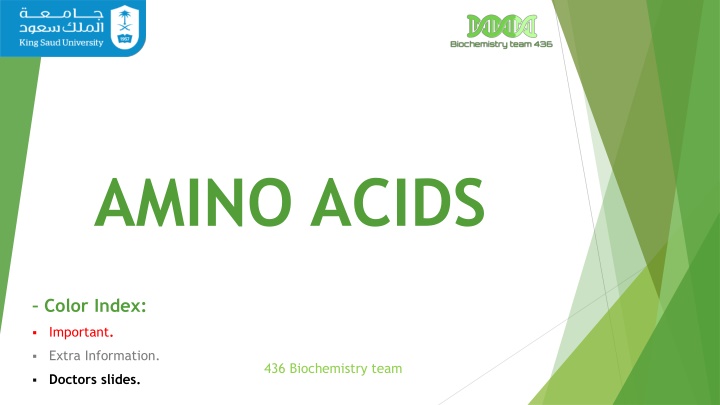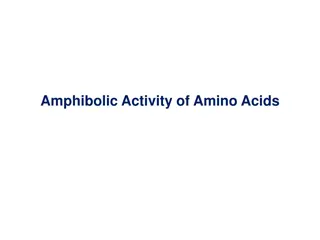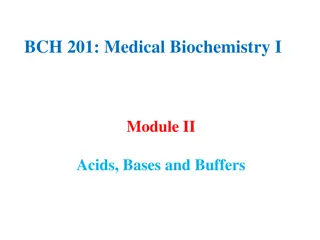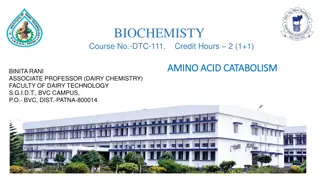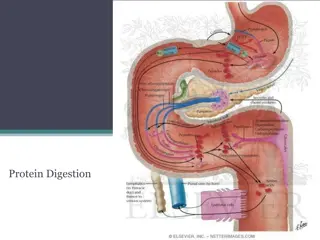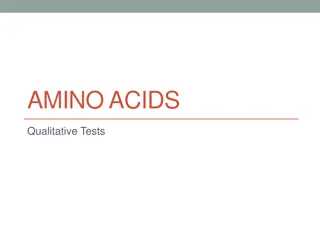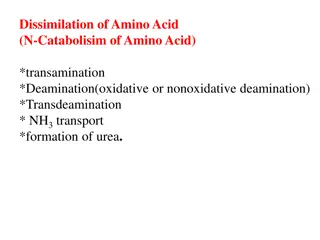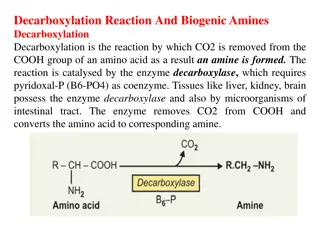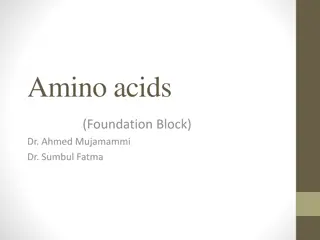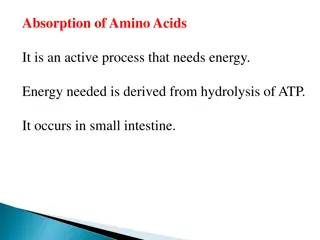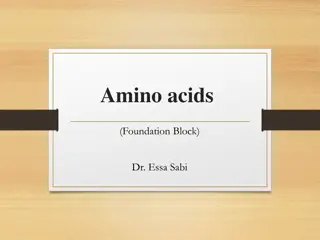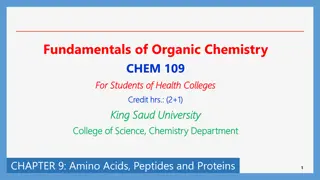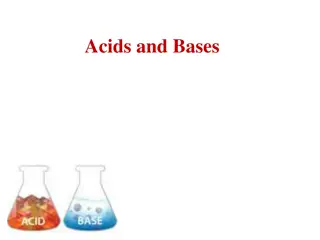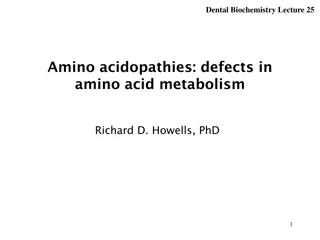AMINO ACIDS
Amino acids are the essential building blocks of proteins, with 20 types classified based on their structures and properties. They play vital roles in metabolism and as the foundation of protein synthesis. Understanding their general structures, optical properties, and derivations is crucial for grasping their significance in biochemical processes. The concept of isoelectric point and zwitterions further adds complexity to their behavior in different pH environments. Additionally, exploring the pKa values provides insights into their acidic nature and ability to donate protons. Delve into the world of amino acids to enhance your knowledge in biochemistry and molecular biology.
Download Presentation

Please find below an Image/Link to download the presentation.
The content on the website is provided AS IS for your information and personal use only. It may not be sold, licensed, or shared on other websites without obtaining consent from the author.If you encounter any issues during the download, it is possible that the publisher has removed the file from their server.
You are allowed to download the files provided on this website for personal or commercial use, subject to the condition that they are used lawfully. All files are the property of their respective owners.
The content on the website is provided AS IS for your information and personal use only. It may not be sold, licensed, or shared on other websites without obtaining consent from the author.
E N D
Presentation Transcript
AMINO ACIDS Color Index: Important. Extra Information. 436 Biochemistry team Doctors slides.
Objectives: What are the amino acids? General structure. Classification of amino acids. Optical properties. Amino acid configuration. Non-standard amino acids. Derivatives of amino acids.
What are the amino acids ? There are 20 amino acids A) Humans can produce about half of amino acids. B) The others must be supplied in the food. 1- the chemical units that combine to form proteins. 2- Type of organic acid that contain both a carboxyl group ( COOH ) and an amino group ( NH2 ). - Amino acids play central roles: A. The building blocks of proteins. B. They play intermediates role in metabolism. When proteins are digested or broken down amino acids are left.
General structure of amino acids: Alpha carbon that is attached to: A) hydrogen atom ( H ) B) side chain ( R ) (which is distinctive for each amino acid and gives the amino acid a unique set of characteristics). C) carboxylic acid group ( COOH ) D) Primary Amino acid group ( NH2 ) ( except for proline which has a secondary amino group). ALPHA CARBON: is between the carboxyl and the amino group.
Isoelectric point (PI) and Zwitterion: Zwitterions are neutral amino acid. Zwitterions can have more than one charge. However, the sum of those charges MUST equal zero. Unlike other compounds, zwitterions Simultaneously have both cationic and Anionic states. The isoelectric point (PI): is the pH at which the molecule carries no net charge.
The molecule in its isoelectric point. If we put it in an acidic or a basic solution, what will happen? Isoelectric point Zwitterion - In an acidic solution: Acidic solutions have low pH, cationic The carboxylic acid will gain a proton (Hydrogen atom) and lose its negative charge. Due to that, the overall charge on the molecule is now positive. It becomes cationic. - In a basic solution: Basic solutions have high pH, anionic The amino group will lose a proton and lose its positive Charge. Due to that, the overall charge on the molecule is now negative. It becomes anionic. * Zwitterion is used to describe the molecule. Isoelectric point is used to describe the pH level. PI and Zwitterion video
PK Value It is the ability of an acid to donate a proton (dissociate). Also known as pKa or acid dissociation constant. The pK values of -carboxylic group is in the range of 2.2. The pK values of -amino group is in the range of 9.4. . pK PK and acidity: Inverse relationship. dr notes: carboxylic group is a stronger acids (with low pk value) than the amino group, so it will give off it's proton first (first pk value = 2.2 ) then the amino group ( higher pk value) will donate afterward (second pk group = 9.4) .
Titration curve of glycine When pK1= pH (2.3) 50% of molecules are in cation form and 50% are in zwitterion form. 5.9 ) 2.3 ( When pK2 = pH (9.6) 50% of molecules are in anion form and 50% are in zwitterion form. 9.6 ) Buffering action is maximum around pK values and minimum at PI. dr. notes: - zwitterion the amino acid itself that has no net charge. - If the side chain contains an ionized group, in this case the amino acid is not a zwitterion. - Buffer is a solution resists change in pH when an acid or base is added into it. - At physiological pH, the a-carboxyl and a- amino groups are dissociated. - All free amino acids and charged amino acids in peptide chains, can serve as buffers.
Titration curve of glycine We are adding alkaline to the solution which means we are adding ( OH-) to the solution. This will increase the ph value of the medium . Since the COOH group in Glycine has lower pk value it will start donating its H proton to the medium first. at ph 2.3 , So it becomes COO and Zwitterion will formed. At this stage (around pk value 1) the buffering will be at its max When the ph value reaches a certain level (9.6) the ammonia group starts donating its H protons and becomes NH2. At this point anionic formed. The buffering hear is at its Max. The buffering here is at its minimum
Classification of amino acids + Amino acids According to: Properties of the side chain Body requirement Conditional Essential Nonessential Polar Nonpolar [ not essential, except in time of illness or stress ] [ body CANNOT make ] [ body CAN make ] (hydrophobic) Histidine isoleucine leucine methionine phenylalanine threonine tryptophan valine Glutamic Alanine Asparagine Aspartic acid Arginine Cysteine Glutamine Tryosine Glycine Proline serine uncharged charged Glu Ala AsAs positive charge (acceptors) negative charge ( donators) PGG CATS * Big cats
Nonpolar amino acids Location of protein? Location of protein? In protein found in aqueous solution (polar environment) Interior of the protein Gives the protein its 3D shape. Location of nonpolar amino acids in proteins In protein located in hydrophobic region interacting with lipid environment to Stabilize protein structure. Outside surface of the protein. Such as membrane (non polar environment) MED435 MED435
Uncharged polar amino acids In an alkaline pH -cysteine and tyrosine can lose a proton Polar hydroxyl group Serine , Threonine and tyrosine Participate in hydrogen bonds Carbonyl group + Amide group Side chain of asparagine and glutamine
Structure + Nonpolar Uncharged polar polar Won t mixed Side chain does not bind or give off protons or participate in hydrogen or ionic bonds. has no charge on the side chain Acidic amino acid on -R Basic amino acid + on -R zero net charge at normal pH. (if we change pH they can become charged) have a negative charge on the R-group (Beacausethey are fully ionized at neutral pH) 2 types: Aspartic acid , Glutamic acid When they are ionized we call them aspartate and glutamate. Andthey are proton donors. amino acid with Polar Acidic side chain: Hydrophobic interactions (Does not love H) Hydrophilic (Loves H) have a positive charge on the R-group (Beacausethey are fully ionized at neutral pH) 3 types: Histidine , Lysine , Arginine Andthey are proton acceptors. amino acid with Polar Basic side chain: Examples: Glycine, Alanine, Valine, Leucine, Isoleucine, Methionine, Phenylalanine, Tryptophan and Proline. Prolineis an Imino acid. (because it has a secondary amino group NH2) Examples: Serine, Threonine, Asparagine, Glutamine, Tyrosine and Cysteine.
Mnemonics Non-polar ProGAV PIL TM proline, glycine, alanine, valine, phenylalanine, isoleucine, leucine , tryptophan, methionine Polar "SomeTimes Cats Try AGrowl" serine, threonine, cysteine, tryrosine , asparagine, glutamine Charged "A Good Lawyer Aims High" Aspartate, Glutamate, Lysine, Arginine, Histidine
Optical properties Asymmetric Symmetric The -carbon of most of the amino acids is attached to four different chemical groups. Glycine is an example of symmetric amino acids -carbon is not attached to 4 different groups Asymmetric molecules are active All mammalian amino acids are optically active except glycine They rotate the plane of polarized light in a polarimeter symmetric molecules are optically inactive. You don't have to memorize it just for better understanding
Amino acid configuration right
Non-standard amino acids Aside from the twenty standard amino acids, there are a vast number of "non-standard" amino acids. These nonstandard amino acids are usually formed through modifications to standard amino acids. *you don't have to memorize the names.
Amino acids derivatives Name Derivative of Role Gamma amino butyric acid (GABA) glutamic acid neurotransmitters Dopamine tyrosine neurotransmitters the mediator of allergic reactions Histamine Histidine An important thyroid hormone Thyroxine Tyrosine
Review ESSENTIAL NON ESSENTIAL CONDITIONAL Isoleucine, Leucine, methionine, phenylalanine, tryptophan and valine. alanine Glycine, proline NON POLAR SIDE CHAINS asparagine Cysteine, glutamine, tyrosine and serine threonine UNCHARGED POLAR SIDE CHAINS ---------------- Aspartic acid, glutamic acid -------------- POLAR SIDE CHAINS ACIDIC Histidine, lysine -------------- arginine BASIC
MCQs + useful videos Proline has a . amino group ? A) Primary B) secondary C) tertiary D) quaternary Histamine derivative of ? A) Glutamic acid B) tyrosine C) tyrosine D) histidine *Proline is an imino acid PK value Classification of amino acids Introduction to amino acids Isoelectric point and zwitterion
PI Calculation Formula Example neutral side chains: pI = 1/2 (pKa1+ pKa2) acidic side chains pI = 1/2 (pKa1+ pKa3) Lowest two pKa basic side chains pI = 1/2 (pKa2+ pKa3) Highest two pKa More details about pI calculation: http://www.mhhe.com/physsci/chemistry/carey5e/Ch27/ch 27-1-4.html
Girls team members: Boys team members: . . . . . . . . . - 1 . . . . . . . - 1 2 3 - 4 - - - 8 - - - 2 3 - - - - 4 5 6 - 5 6 7 - 7 - 9 -Team leaders: -Contact us: . . Biochemistryteam436@gmail.com twitter.com/436biochemteam
